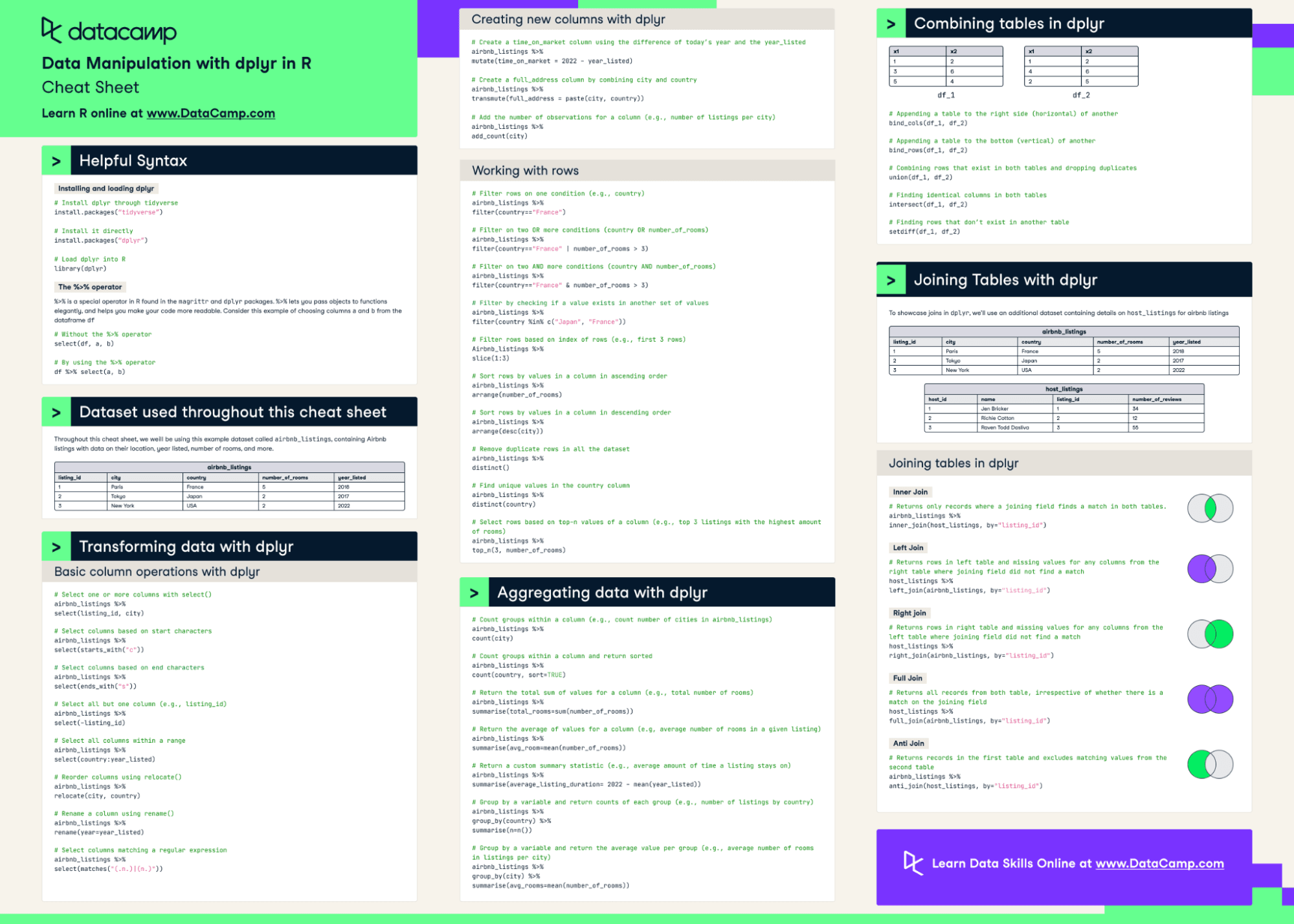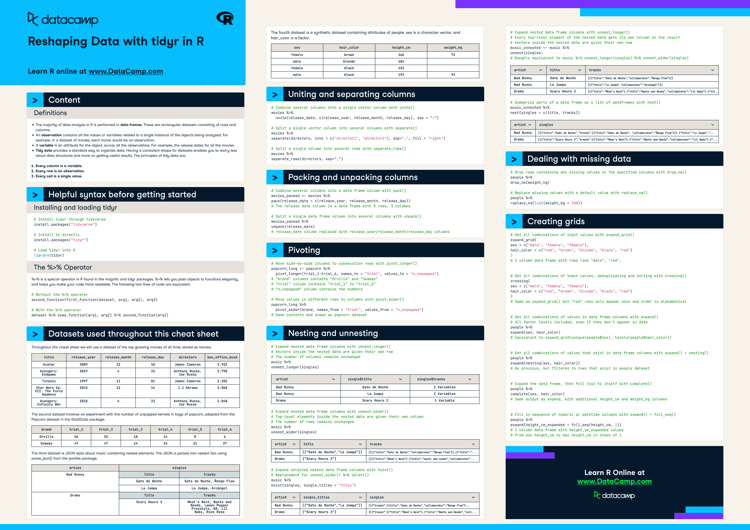Dplyr is one of the most widely used tools in data analysis in R. Part of the tidyverse, it provides practitioners with a host of tools and functions to manipulate data, transform columns and rows, calculate aggregations, and join different datasets together.
In this cheat sheet, you'll find a handy list of functions covering dplyr functions —all collected from our Data Manipulation with dplyr course.
Have this cheat sheet at your fingertips
Download PDFHelpful syntax to know
Installing and loading dplyr
# Install dplyr through tidyverse
install.packages(“tidyverse”)
# Install it directly
install.packages(“dplyr”)
# Load dplyr into R
library(dplyr)The %>% operator
%>% is a special operator in R found in the magrittr and dplyr packages. %>% lets you pass objects to functions elegantly, and helps you make your code more readable. Consider this example of choosing columns a and b from the dataframe df
# Without the %>% operator
select(df, a, b)
# By using the %>% operator
df %>% select(a, b)Dataset used throughout this cheat sheet
Throughout this cheat sheet, we will be using this example dataset called airbnb_listings, containing Airbnb listings with data on their location, year listed, number of rooms, and more.
| airbnb_listings | ||||
| listing_id | city | country | number_of_rooms | year_listed |
| 1 | Paris | France | 5 | 2018 |
| 2 | Tokyo | Japan | 2 | 2017 |
| 3 | New York | USA | 2 | 2022 |
Transforming data with dplyr
Basic column operations with dplyr
# Select one or more columns with select()
airbnb_listings %>%
select(listing_id, city)
# Select columns based on start characters
airbnb_listings %>%
select(starts_with(“c”))
# Select columns based on end characters
airbnb_listings %>%
select(ends_with(“s”))
# Select all but one column (e.g., listing_id)
airbnb_listings %>%
select(-listing_id)
# Select all columns within a range
airbnb_listings %>%
select(country : year_listed)
# Reorder columns using relocate()
airbnb_listings %>%
relocate(city, country)
# Rename a column using rename()
airbnb_listings %>%
rename(year = year_listed)
# Select columns matching a regular expression
airbnb_listings %>%
select(matches(“(.n.) | (n.)”))Creating new columns with dplyr
# Create a time_on_market column using the difference of today’s year and the year_listed
airbnb_listings %>%
mutate(time_on_market = 2022 - year_listed)
# Create a full_address column by combining city and country
airbnb_listings %>%
transmute(full_address = paste(city, country))
# Add the number of observations for a column (e.g., number of listings per city)
airbnb_listings %>%
add_count(city)
Working with rows
# Filter rows on one condition (e.g., country)
airbnb_listings %>%
filter(country == "France")
# Filter on two OR more conditions (country OR number_of_rooms)
airbnb_listings %>%
filter(country == "France" | number_of_rooms > 3)
# Filter on two AND more conditions (country AND number_of_rooms)
airbnb_listings %>%
filter(country == "France" & number_of_rooms > 3)
# Filter by checking if a value exists in another set of values
airbnb_listings %>%
filter(country %in% c( "Japan", "France"))
# Filter rows based on index of rows (e.g., first 3 rows)
Airbnb_listings %>%
slice(1:3)
# Sort rows by values in a column in ascending order
airbnb_listings %>%
arrange(number_of_rooms)
# Sort rows by values in a column in descending order
airbnb_listings %>%
arrange(desc(city))
# Remove duplicate rows in all the dataset
airbnb_listings %>%
distinct()
# Find unique values in the country column
airbnb_listings %>%
distinct(country)
# Select rows based on top-n values of a column (e.g., top 3 listings with the highest amount of rooms)
airbnb_listings %>%
top_n(3, number_of_rooms)Aggregating data with dplyr
# Count groups within a column (e.g., count number of cities in airbnb_listings)
airbnb_listings %>%
count(city)
# Count groups within a column and return sorted
airbnb_listings %>%
count(country, sort = TRUE)
# Return the total sum of values for a column (e.g., total number of rooms)
airbnb_listings %>%
summarise(total_rooms=sum(number_of_rooms))
# Return the average of values for a column (e.g, average number of rooms in a given listing)
airbnb_listings %>%
summarise(avg_room = mean(number_of_rooms))
# Return a custom summary statistic (e.g., average amount of time a listing stays on)
airbnb_listings %>%
summarise(average_listing_duration = 2022 - mean(year_listed))
# Group by a variable and return counts of each group (e.g., number of listings by country)
airbnb_listings %>%
group_by(country) %>%
summarise(n = n())
# Group by a variable and return the average value per group (e.g., average number of rooms in listings per city)
airbnb_listings %>%
group_by(city) %>%
summarise(avg_rooms = mean(number_of_rooms))Combining tables in dplyr
df_1
| x1 | x2 |
| 1 | 2 |
| 3 | 6 |
| 5 | 4 |
df_2
| x1 | x2 |
| 1 | 2 |
| 4 | 6 |
| 2 | 5 |
# Appending a table to the right side (horizontal) of another
bind_cols(df_1, df_2)
# Appending a table to the bottom (vertical) of another
bind_rows(df_1, df_2)
# Combining rows that exist in both tables and dropping duplicates
union(df_1, df_2)
# Finding identical columns in both tables
intersect(df_1, df_2)
# Finding rows that don’t exist in another table
setdiff(df_1, df_2)
Joining tables with dplyr
To showcase joins in dplyr, we’ll use an additional dataset containing details on *host_listings* for airbnb listings
| airbnb_listings | ||||
| listing_id | city | country | number_of_rooms | year_listed |
| 1 | Paris | France | 5 | 2018 |
| 2 | Tokyo | Japan | 2 | 2017 |
| 3 | New York | USA | 2 | 2022 |
| host_listings | |||
| host_id | name | listing_id | number_of_reviews |
| 1 | Jen Bricker | 1 | 34 |
| 2 | Richie Cotton | 2 | 12 |
| 3 | Raven Todd Dasilva | 3 | 55 |
Joining tables with dplyr
Inner Join
# Returns only records where a joining field finds a match in both tables.
airbnb_listings %>%
inner_join(host_listings, by = "listing_id")Left Join
# Returns rows in left table and missing values for any columns from the right table where joining field did not find a match
host_listings %>%
left_join(airbnb_listings, by = "listing_id")Right Join
# Returns rows in right table and missing values for any columns from the left table where joining field did not find a match
host_listings %>%
right_join(airbnb_listings, by = "listing_id")
Full Join
# Returns all records from both table, irrespective of whether there is a match on the joining field
host_listings %>%
full_join(airbnb_listings, by = "listing_id")
Anti Join
# Returns records in the first table and excludes matching values from the second table
airbnb_listings %>%
anti_join(host_listings, by = "listing_id")


